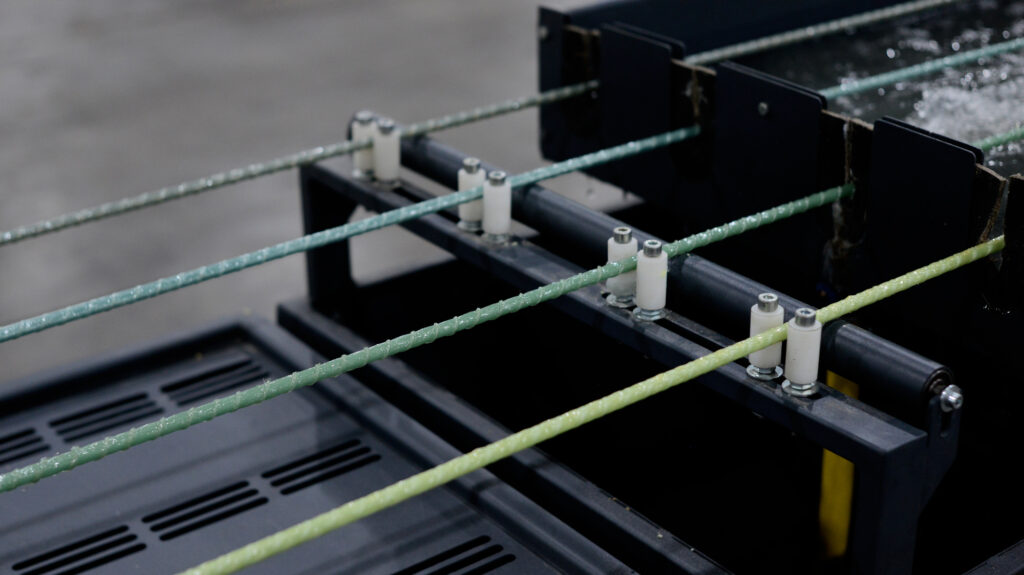For nearly two centuries, steel rebar has been a fundamental component in reinforced concrete construction, providing strength and durability to buildings and infrastructure. However, a new contender is rapidly emerging: Glass Fibre Reinforced Polymer (GFRP). With its superior technical performance and numerous advantages over traditional steel, GFRP is redefining the standards for modern construction and gaining widespread popularity as a durable and innovative alternative.
Looking at the key differences between GFRP and steel, by focusing on strength, durability, lifecycle, maintenance, weight, conductivity and sustainability, it is easy to see why GFRP will continue to gain traction in the South African construction industry and perhaps even replace steel.
Through intensive testing, it has been proven that GFRP rebars, that are made up of approximately 75% to 80% glass fibre and 20% to 25% polymers, have a higher tensile strength compared to steel, often exceeding double the tensile strength. For instance, GFRP can achieve tensile strengths of over 1000 MPa, while steel typically ranges from 450 to 690 MPa. This means that while steel can deform, GFRP rebar and mesh maintain their structural integrity without yielding, making them highly resistant to permanent deformation.
As there are no corrosive components in its manufacturing, GFRP is highly resistant to corrosion, making it ideal for harsh environments such as marine structures or areas exposed to chemicals. In Saudi Arabia, this technology was used in the Jizan Flood Mitigation Channel, one of the largest GFRP rebar projects globally, spanning 23 kilometres. This exemplifies how GFRP effectively is being employed in large-scale infrastructure projects where the non-corrosive nature of GFRP is the ideal choice for structures of this nature.
Even in non-critical infrastructure, such as sidewalks, we have seen the occurrence of spalling in concrete as a result of the pressure and degradation of steel from corrosion and rust.
Spalling is typically seen when surface patches of concrete breaks up and delaminates in the absence of immediate external influences, that indicates it comes from within the structure.
Therefore, non-ferrous materials like GFRP require less maintenance over its lifecycle compared to steel, that can necessitate costly repairs. Studies have found that concrete also bonds better with the GFRP rebars when compared to traditional steel, meaning that it provides great durability and ductility.
Weighing approximately 25% of equivalent steel rebar, GFRP significantly reduces transportation and installation costs. At a recent construction site, a contractor highlighted the ergonomic benefits of GFRP’s lighter weight. He noted that using this technology resulted in less physical strain on workers’ bodies, leading to fewer injuries. The contractor estimated that implementing GFRP could potentially extend the careers of him and his crew by at least 20 years due to reduced wear and tear on their bodies.GFRP offers superior thermal insulation due to its lower thermal conductivity compared to steel. This property is particularly advantageous in South Africa’s predominantly hot climate. Unlike steel rebar and mesh, which can become uncomfortably hot after prolonged sun exposure, GFRP maintains a more manageable temperature. As a result, construction workers can handle GFRP materials more comfortably and safely throughout the day, even during peak sun hours. This thermal characteristic not only enhances worker comfort but also contributes to improved safety and efficiency on construction sites.
As GFRP emits significantly less carbon dioxide (CO₂) during production compared to steel it is expected to play a growing role in national and municipal infrastructure projects aimed at decarbonisation. Additionally, GFRP’s lighter weight reduces transportation emissions, further enhancing its environmental benefits.
South Africa, which aims to lower greenhouse gas emissions and achieve net-zero emissions by 2050, as outlined in the updated Nationally Determined Contribution, can leverage GFRP to meet these ambitious targets. By reducing carbon emissions associated with both material production and transportation, GFRP contributes to greener construction practices and aligns with the country’s long-term climate strategy.
An important trade-off to consider when comparing GFRP rebar to steel rebar is its resale value. Unlike steel, GFRP cannot be easily recycled by melting it down and repurposing it into new products. However, GFRP can be reused on other projects if a company chooses to do so, offering a practical alternative to recycling. In a local context, this characteristic also makes GFRP products less likely to be stolen from construction sites, as they lack the immediate scrap value of steel. Furthermore, the superior durability and performance of GFRP can enhance the long-term value of structures by ensuring extended lifespans and reducing maintenance requirements, potentially increasing their overall resale value.
With numerous technical advantages over steel rebar and mesh – such as exceptional corrosion resistance, higher tensile strength, lighter weight and non-conductivity – GFRP stands out as a compelling solution for modern construction. Its long-term benefits not only contribute to more sustainable and durable structures but also align with the growing demand for environmentally friendly and cost-effective building materials. As the construction industry continues to prioritise resilience and sustainability, GFRP is poised to play a pivotal role in shaping the future of infrastructure developmenthttps://gfrptech.co.za/.


